Scottish brand Deviate Cycles has officially launched today with its new Guide carbon enduro bike. For a detailed rundown of the bike and its specs, check out our first look article here. Otherwise, read on for Sanny’s world exclusive first ride review of this unique gearbox-equipped machine.
An e-mail appears (albeit without the fanfare of the little tune that you used to get with AOL). It is from the Captain. “I want to introduce you to Ben. He has started a bike company with his mate Chris and they have a bike I reckon you would be interested in.” My curiosity piqued, I e mail Ben. What could it be? As Singletrack’s aficionado of the slightly weird and unusual, my mind started to wander. A fat biked Unicycle? An electric recumbent?
Nope, this was something more within the mainstream – a full carbon, Pinion gearbox toting, 160mm trail slayer designed and developed here in the UK and tested in the Alps by the two professional guides behind Deviate Cycles, Chris Deverson and Ben Jones. Excited? I should coco. Ever since I clapped eyes on a Zerode Tanihwa, I have wanted to try a gearbox bike. The easy maintenance regime (an infrequent oil change and the odd chain lube) coupled with there being no possibility of ripping off yet another rear mech for the umpteenth time had me hooked.
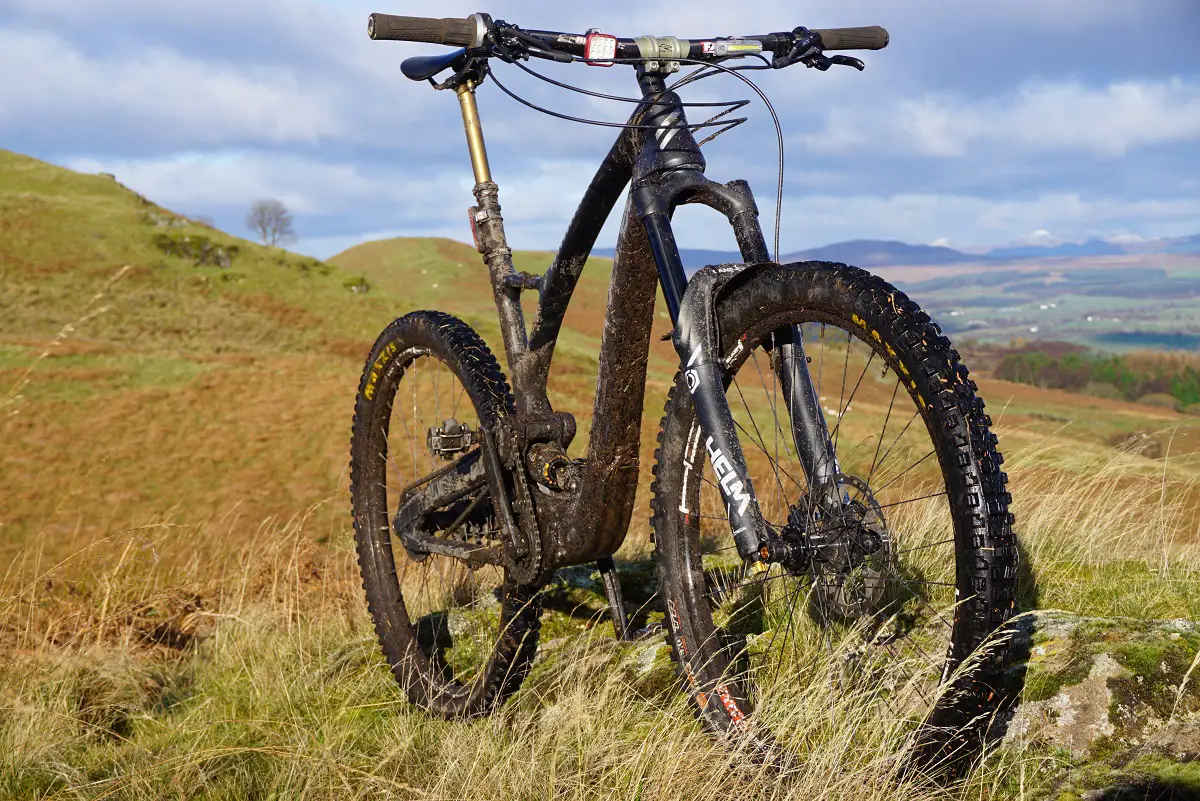
But in a bike industry where sales are falling and with the longest suicide note in history a la Brexit looming large, it takes no small amount of confidence and belief in a product to jump head first into bike manufacture. I’ll let Chris explain.
So why now?
“Having worked for Prodrive in the world of Motorsport’s, I’ve developed a keen understanding of what works and what doesn’t. In motorsport, we would develop engineering solutions to problems instead of persevering with technology that wasn’t up to the job. Thinking about bikes and the experience I had built up in the field with Ben as a mountain bike guide in the Alps, I came to realise that bikes simply aren’t being designed for the harsh environment they are used in. After repairing more bikes with ripped off mechs than I care to remember, I felt there had to be a better solution. A season in New Zealand proved to be a bit of an eye opener when I had the chance to ride a gearbox bike. I was completely blown away by the possibilities of what it could mean for improving suspension performance.”
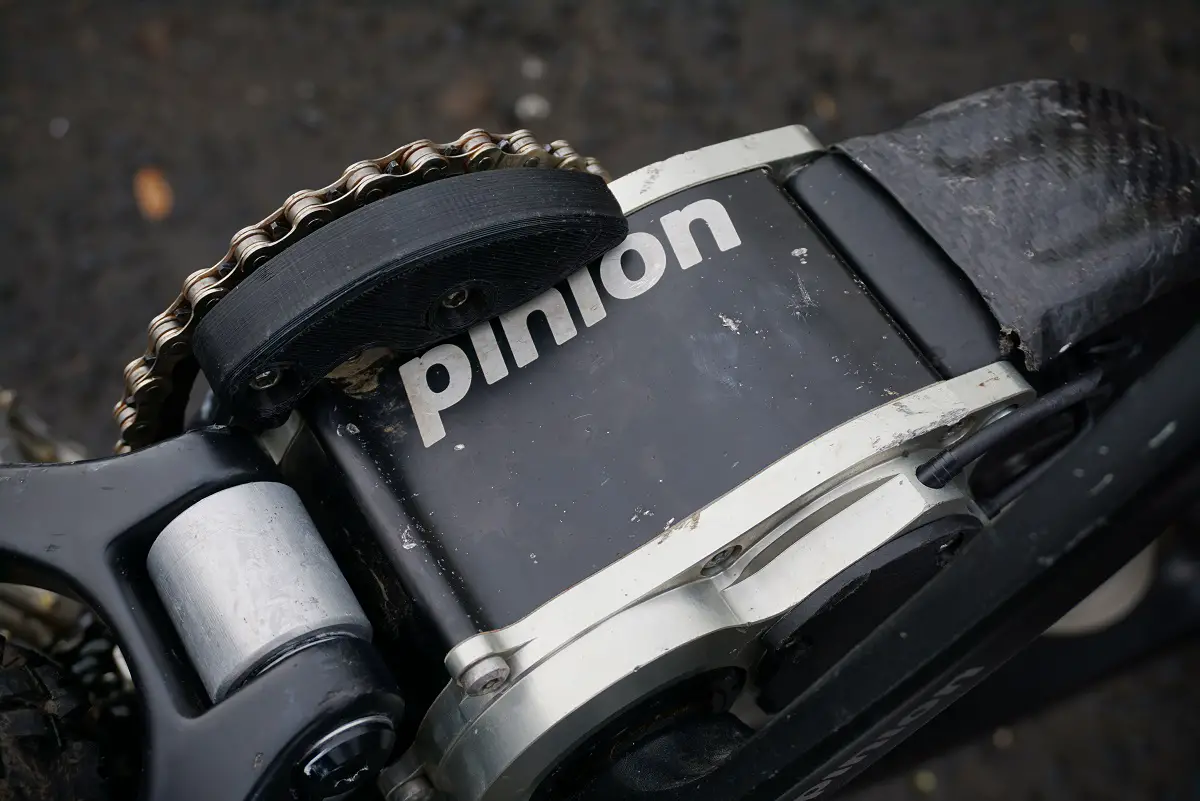
“Immediately the mechanical engineer in me started thinking about how I could improve upon the design and make it even better. As such, I started spending an awful lot of time in my shed. Between a full time job, becoming a father and spending on average 5 hours a night in the shed designing, building and testing prototype carbon frames, I’ve ate, slept and breathed this project full time for over two years.”
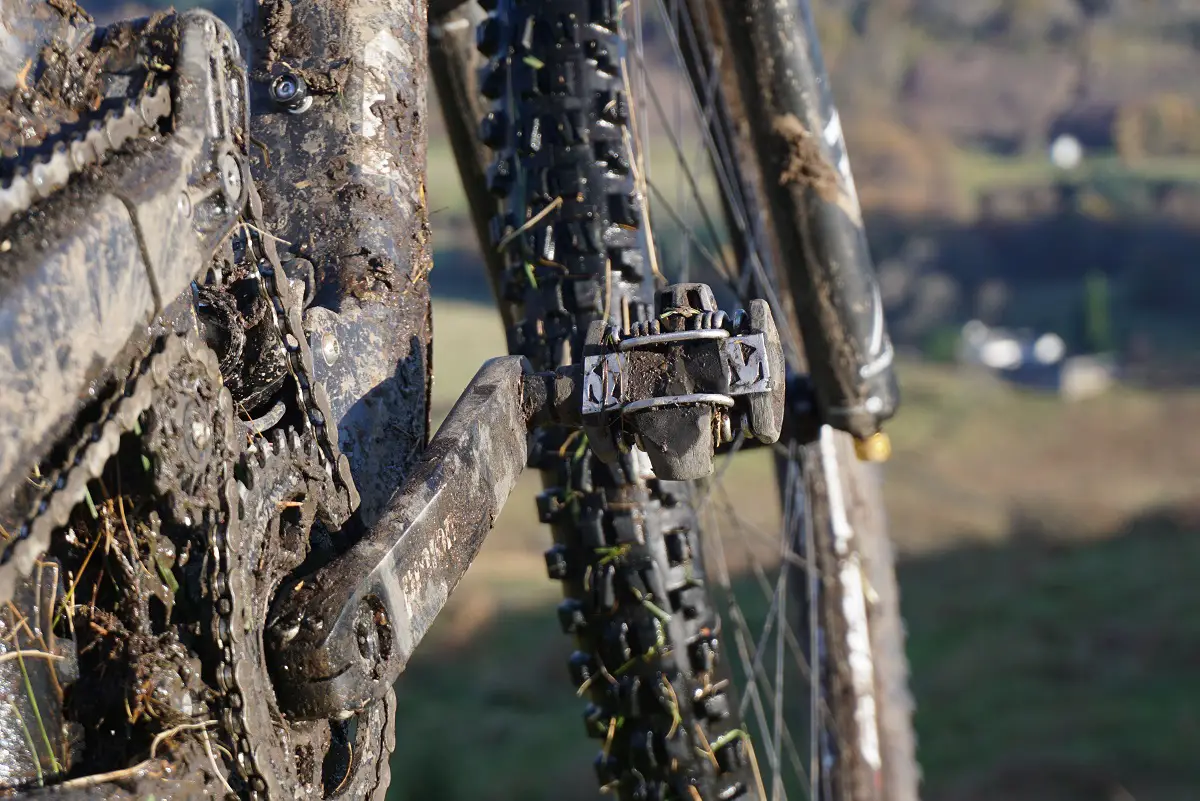
So an overnight success many years in the making?
Chris laughs. “Yes. You could say that. With Ben, I have a business partner who can take my engineering designs and translate them into terms that the average rider can understand. He is the sales arm of the business while bringing many years of riding experience to the project which has been invaluable in getting us to where we are now with a frame that we are proud to offer to the public and which we believe offers significant advantages over current designs.”
So just what is so special about the Guide’s design?
“Unlike bikes with a normal drivetrain, we have been able to design the frame such that the suspension is optimised to work with a fixed chainline. On a bike which has a rear cassette, the chainline alters depending on what gear you are in and the suspension action is compromised. The Guide features a high pivot point, which, when coupled with our idler means that we have been able to fine tune the perfect combination of plush suspension, desirable anti-squat characteristics and zero pedal kickback. In practical, easy to understand terms, the suspension remains active even under pedalling load.”
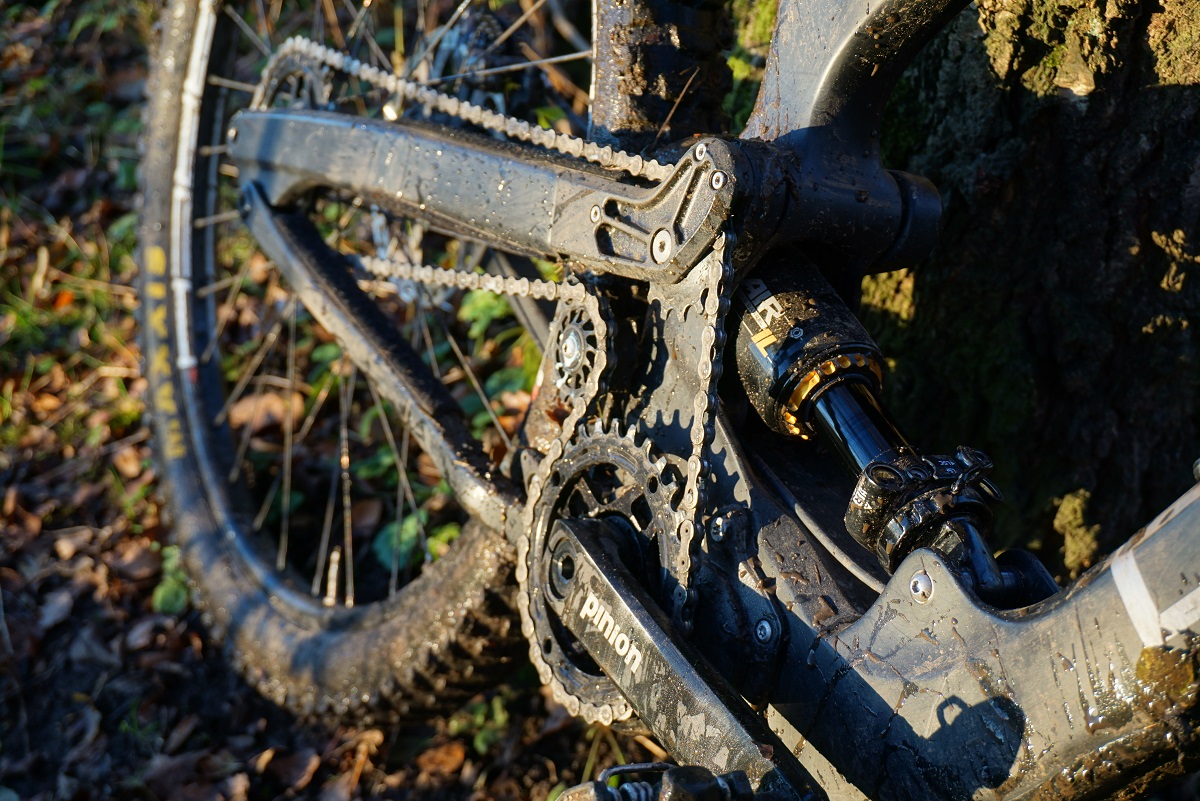
Blimey!
“Exactly. Once you ride it, you’ll see what I mean”
So other than the unique suspension and the rider led design, what are you particularly proud of?
“The sealed bearings. I know they aren’t particularly sexy but we’re really proud of our twin lip wiper seals on all of the bearings. So many current designs are compromised when it comes to bearings, which struggle to cope with water, mud and grit. We’ve designed our bike to last and be there for the long haul. The frame is warrantied for two years while the gearbox comes with a five year warranty as standard.”
So what else do you have in the pipeline?
“Hopefully, the Guide will help us establish the brand. We want to be known as a company that prides itself on building high quality bikes that offer an engineering and rider-led solution where it is the ride experience that matters. I have lots of ideas floating about my head about what to do next but for now, our focus is on the Guide.”

Enter stage left, Ben Jones.
Just as Butch Cassidy has his Sundance Kid, so Chris has Ben. Ben is the front man of Deviate Cycles. A mountain bike guide of many years standing who has plied his trade in the Alps and Scotland, he knows better than most what works and what doesn’t when you spend your working day riding bikes on some of the most demanding trails in the world. For every design and modification Chris develops, Ben is the one who puts it through its paces.
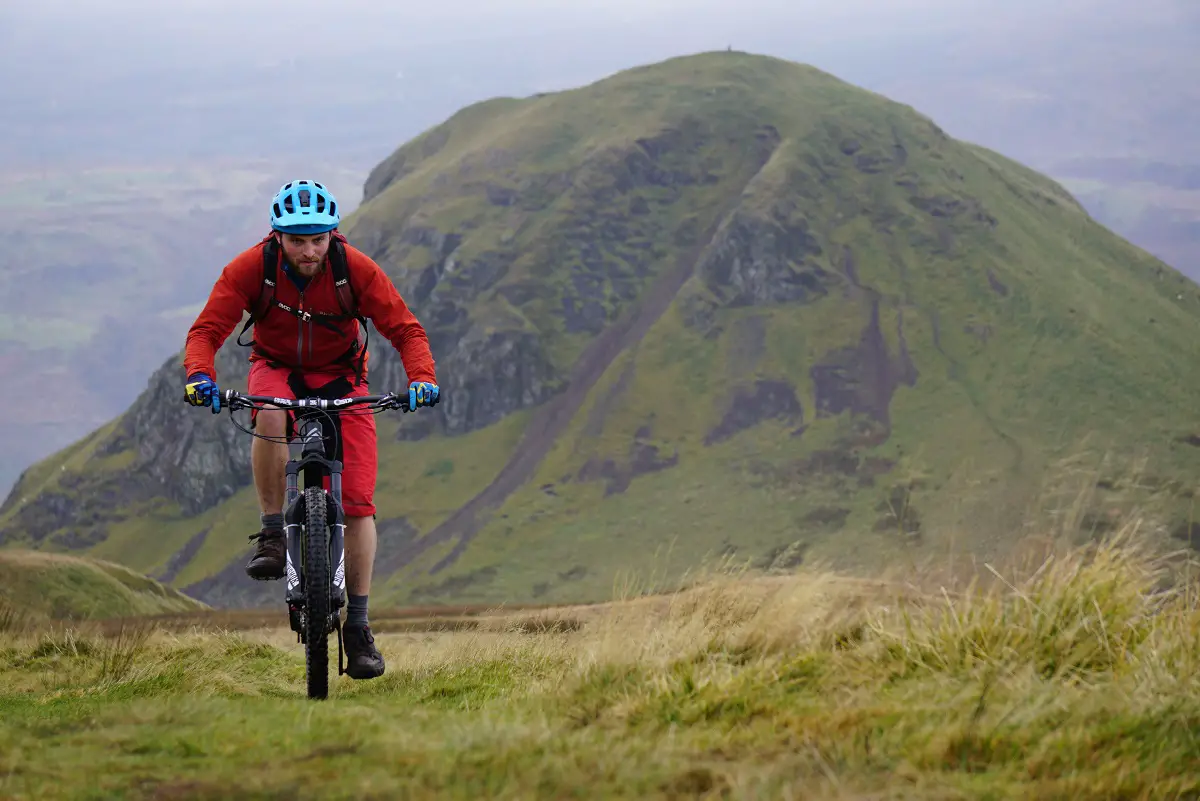
I first meet Ben when he knocks at my door one Sunday night in early November. Now normally I wouldn’t answer the door when “Strictly – The Results” are on (Aston got booted off – Boo!) but one look at the bike and Strictly was consigned to an iPlayer catch up. Ben is affable and eloquent. He has the self-assured confidence of someone who is happy to let his riding do the talking and is far more interested in talking trails and adventures than geometry charts, suspension settings and mid-stroke, whatever the hell that is. We talk about the design, the choice of components where the emphasis is on quality and longevity, the use of twin lip wiper seal bearings and how he has spent the entire season ragging this particular bike in the Alps and in Scotland. A plan is hatched and we agree to meet for a ride although to my delight he leaves the bike with me and asks me to give it a proper shakedown prior to our ride. Which I do. Several times. And then some more on top for good measure!
Enough with the background already! What’s it like to ride?
Getting my grubby little paws on the UK spec’d bike, I did the standard lift it up and scratch my chin test. Weighing in at a real world 33 pounds with pedals, it isn’t going to break any weight records but it is how it carries the weight that matters. Being designed around a philosophy that recognises that spec’ing super lightweight tyres and wheels can leave you high and dry when the going gets chunky, steep and rocky, my test bike came supplied with Maxxis Minion DHF 2.5in tyres rolling on Stan’s NoTubes Mk3 Arch rims. Try as I might, I singularly failed to bend the rims nor damage the sidewalls of the tyres. While you could easily lose several hundred grams by opting for a lighter pairing, I can’t help but feel that that would be missing the point of the bike somewhat.
Size wise, I rode the medium frame. Despite being some 6 foot 1, it didn’t feel in any way cramped or short. Even with the shortest stem I have ever ridden on a bike (shorter even than that on the BMX I had as a kid), a Renthal 33mm number matched with oversize carbon Renthal Fatbar 35s which measured in at a gorilla-like 800mm, the bike felt well balanced.
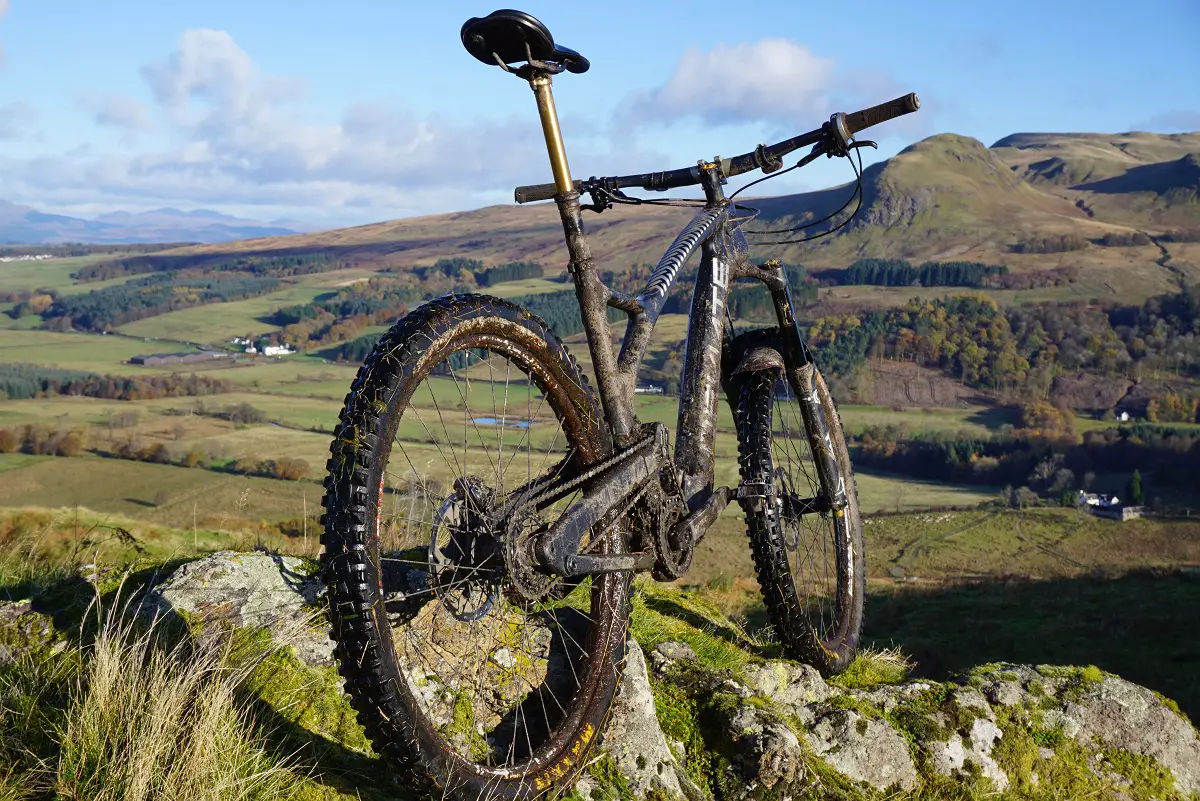
The carbon railed Fabric saddle proved pleasingly comfortable while dropper duties were handled by a Fox Transfer post. For production, Deviate will be supplying a 9 point 8 cable actuated dropper as they consider them to be a more reliable option having killed a couple of Fox posts when testing in the Alps. Braking duties are assigned to Shimano’s workhorse Deore XT (180mm rotors as tested, 203mm rotors being supplied on the Alps build). Bouncy bits come courtesy of Cane Creek with a double barrel air shock out back to keep your butt happy while a seriously stout 160mm Helm fork rounds things off out front.

And then there is the drivetrain. With the recent launch of the Pinion C-Line range in 2017, Pinion has taken its 10 years of experience in gearbox design and fitted it into a lighter magnesium shell which sheds more than half a pound off the weight of the original gearbox. While it still weighs just over 2kg, all of the weight is centred around the bottom bracket area. With no vulnerable rear mech and hanger to worry about, the Deviate positively encourages you to take tight lines through gullies and rock gardens that would have you off and walking otherwise.
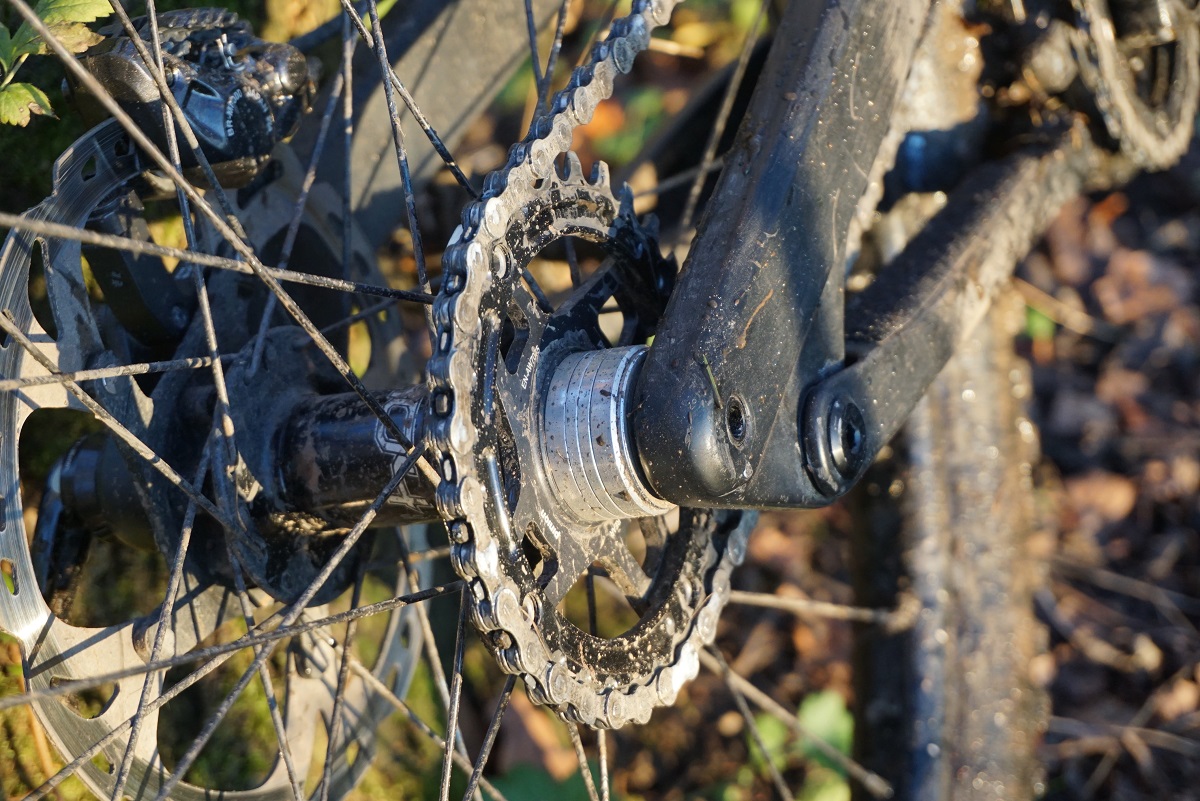
Unlearn to learn
The first thing I noticed was the ability to shift while stationary. In the real world, this meant I was able to track stand while lining myself up for a thrutchy move up a rock slab or over a fallen log. At traffic lines, it was twist, click and go. Requiring two cables to change gear, the gearbox employs a Grip shift style shifter, albeit one that is beautifully machined. As someone who regularly swaps between bikes with Grip shift, trigger shift and thumbies, it didn’t take me long to feel at home.
On familiar cross country trails, I had to do a bit of unlearning in order to get the best out of the gearbox. Rather like a clutch on a car, you have to back off on the pedals to change gear. Try cranking down and nothing will happen. On step ups, log hops and other slow speed tech, the key is to be in the right gear as you finalise your approach. You can’t panic shift under pedalling load. This felt a bit odd at first and goes counter to many years of cycling experience. I’ve read reviews of the system where the reviewer has struggled to come to terms with the design but after a full day of riding, shifting became second nature. I had to change my riding style a little but there is a significant payback to be had in terms of overall suspension performance of the bike.
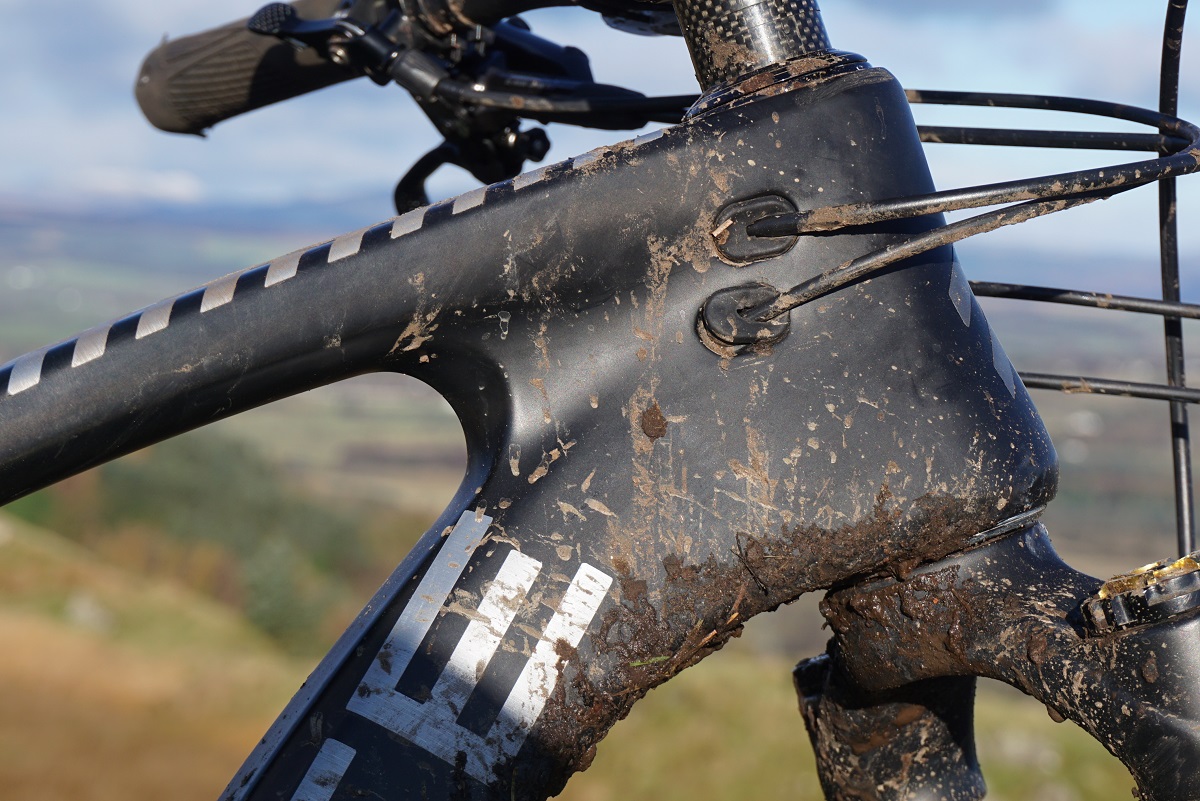
Being box fresh, Ben warned me that the gearbox would need to be bedded in over several hundred miles. It may just be me but I didn’t consider that it needed bedding in. It worked flawlessly throughout the test and didn’t feel in any way draggy. In terms of gearing, it offers a staggering 600% gear ratio with the gears spread evenly through that range. In practical terms, this meant I only needed to change one gear at a time instead of the two I am used to with a regular drivetrain. At no point did I feel the need for a lower gear, something that other one by drivetrains I have tried have failed to deliver, for me at least.
So THIS is how suspension is meant to work!
At first sight, the Guide has a real purposeful look to it. It positively shouts “Come ahead trail if you think you are hard enough”, a feeling enhanced by a feeling of assured solidity. Despite having been subjected to a full season of uplift, hike-a-bike, climbing and descents measured in hours and not just metres in the Alps, the bike felt like new. Nothing creaked. There was no hard to locate squeak. Everything felt tight. Were it not for a tell-tale minor mark on the down tube, you could be forgiven for thinking that it was fresh from the factory. Knowing the state some of my bikes have come back from trips to the Alps (cracked frame, blown fork damper, leaking brakes, collapsed rim, shredded tyres etc.), it’s safe to say I was impressed.
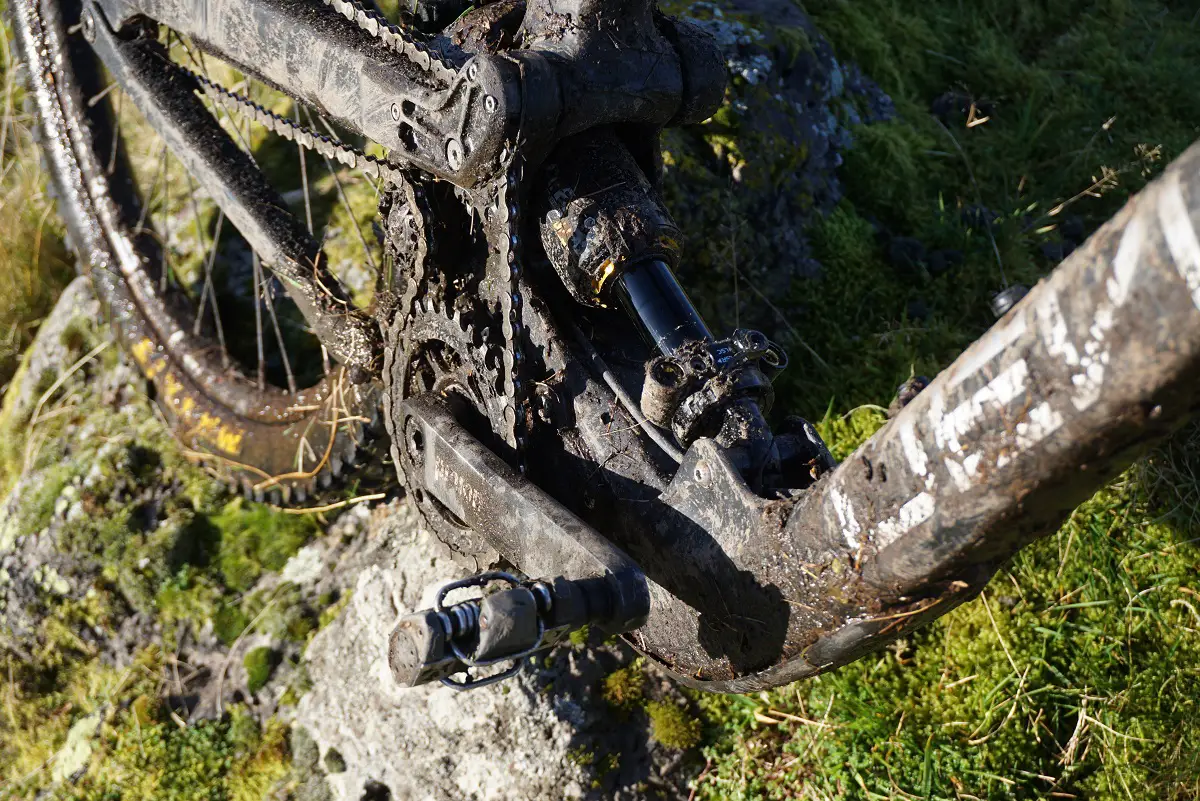
Jumping on the bike, it feels much like any other modern geometry suspension bike. However, show it rock gardens, stutter bump strewn descents, roots and pretty much everything else that is lumpy and something rather special happens. I first noticed it while pedalling hard through a rock garden on a trail close to Sanny HQ. It gently rises but on hitherto every full suspension bike I have ridden over it to date, I could feel the suspension fighting against my pedalling action. The harder I would pedal, the less supple the suspension felt. With the Guide, I had a design that allowed the suspension to keep working despite me pedalling. With that, I headed of in search of other lumpy sections of trail to see if this was a one off. Fortunately, it wasn’t. I don’t pretend to understand the technicality of how the design works. All I know is that it works and bloody well it does too.
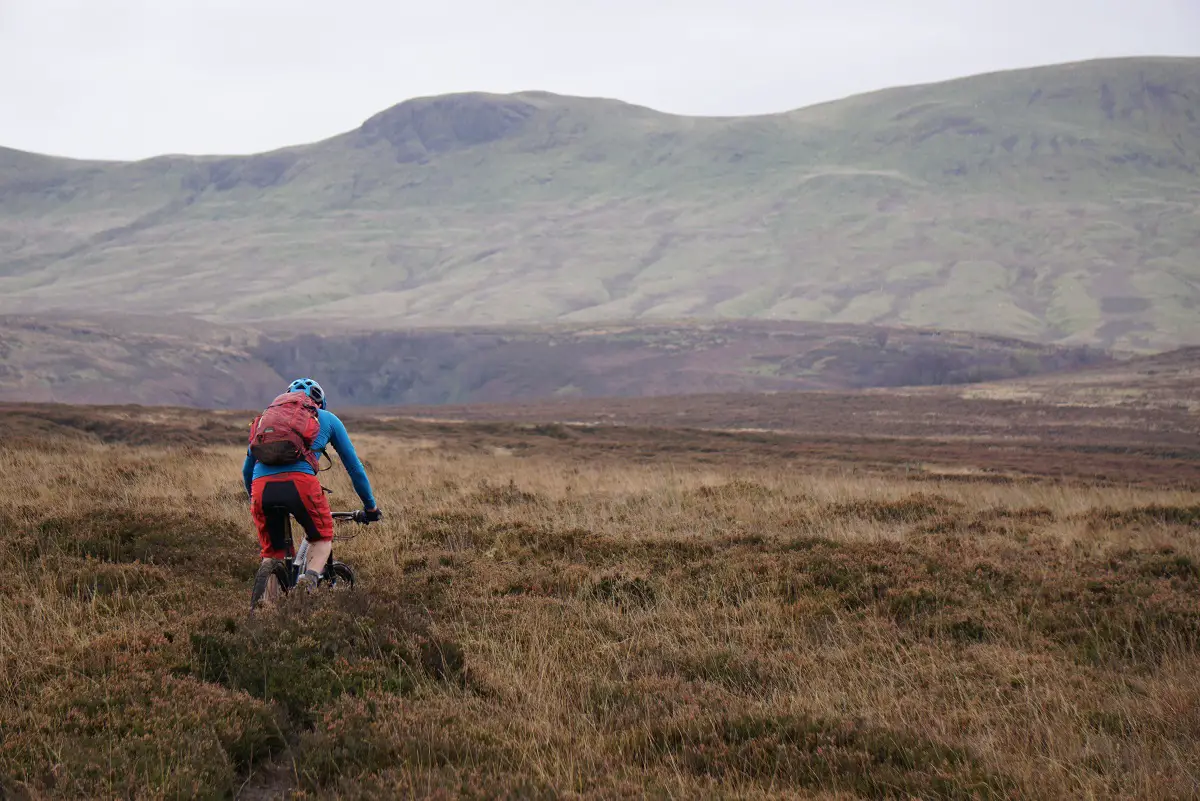
The more I rode it, the more I came to appreciate it. Jumping back onto my own full susser, a Turner Sultan, I realised that from both a drivetrain and a suspension perspective, I had been shown the good stuff but would have to go back to something just that little bit disappointing in comparison. Bollox!
On steep (and I mean 47 degree steep) descents, the bike has an assured stability. With the weight kept central, the bike stays on line until you want to change it. It doesn’t get easily deflected and to some extent feels more like a DH bike when you head downwards. After a baptism of fire in Whistler earlier in the year, it is a feature I immediately liked. On long descents, the suspension keeps taking the hits and comes back for more. There is no feeling of packing down that I sometimes experience on my own bike. As such, I would dearly love to try it on familiar Alpine trails to see how it performs there. Rather well I suspect.
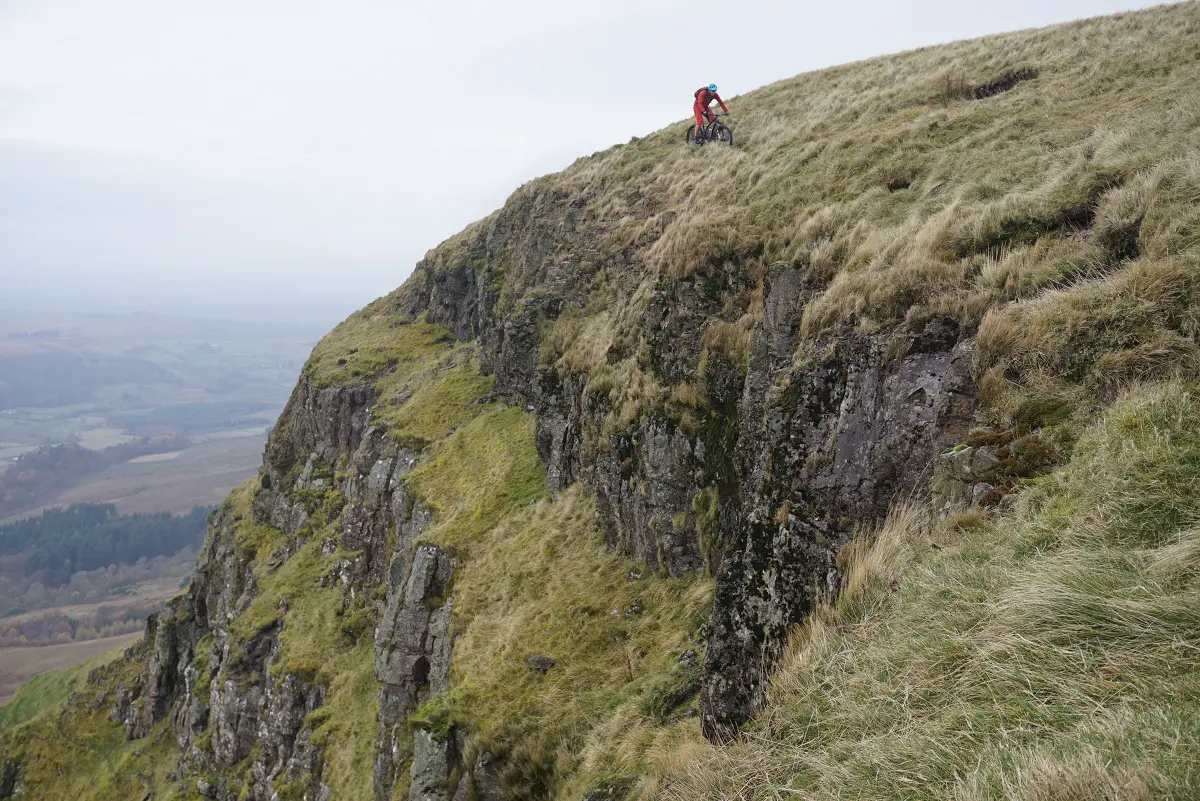

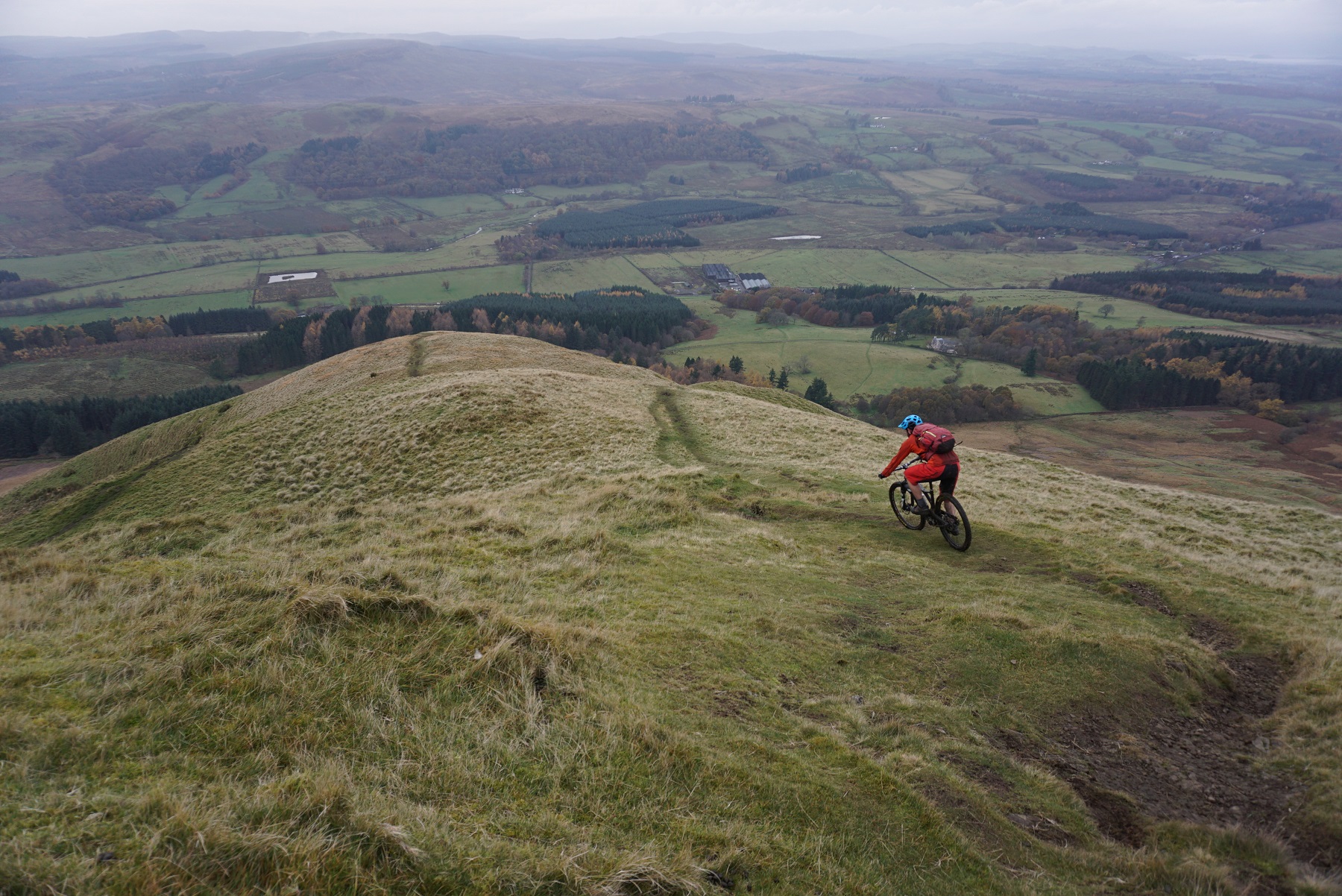
Up, up and away!
“It’s not really a climber’s bike” said Ben to me when we met for our ride. As someone who reckons his best climbing bike is a near 40 pound fat bike, I was open to see how it would perform. The ultra-short stem and wide bar combo didn’t strike me as being suited for climbing but sometimes the way something looks and reads on paper bear no relation to reality. Heading into the Campsie Fells north of Glasgow, we headed over open heather covered moorland to reach our test piece climb. The lack of rear mech as we rode between tussocks on a fine sliver of singletrack was greatly appreciated. The climb itself is unrelenting. Over 1000 feet of near uninterrupted ascent of fire road, quad bike track, exposed bedrock and short cut grass, it is brutal. Add in some heavy rain in the days preceding and you have a recipe for fruity language as you gurn and grunt your way ever upwards.
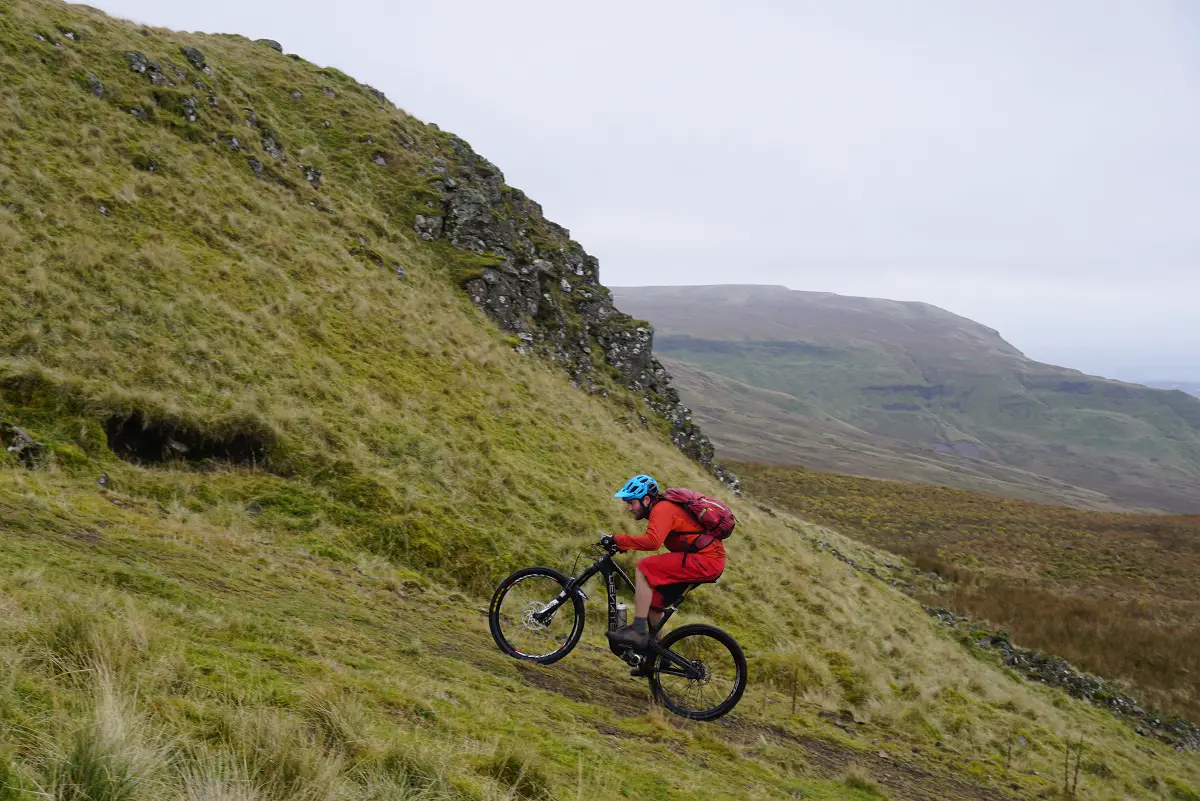
Engaging my lowest gear, I set off up the steepest section, spinning for the win while Ben carried beside me. Every time I thought I was going to spin out, I didn’t. I just kept going despite Minions not being renowned for their performance on mud and wet grass. I could see the suspension working beneath me. I had traction when really I shouldn’t have. The bar and stem combo weren’t in any way climbing friendly but as I eventually topped out at the summit, it was clear that in the right hands, the Guide can climb and then some.
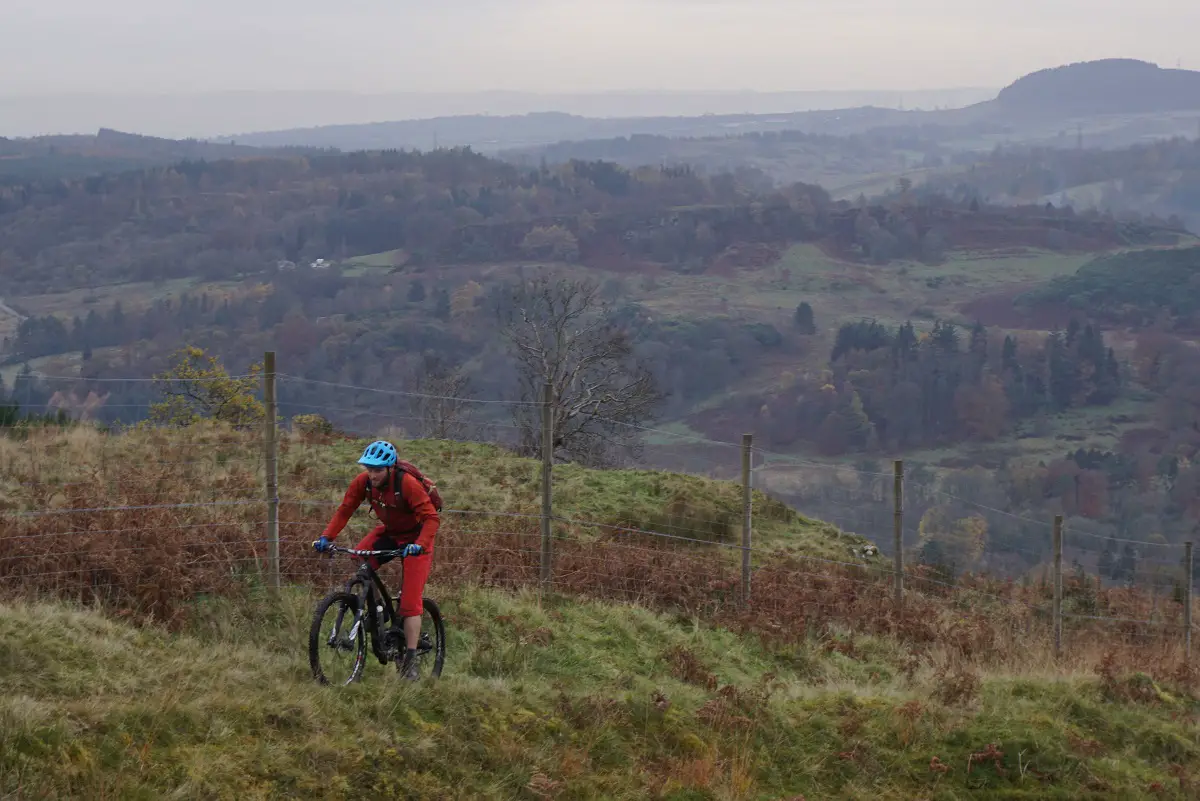
With all the mud and gloop to contend with, the Guide did a good job of keeping things running freely. Mud clearance is excellent. While there was some build up behind the seat tube, at no point did it compromise the bike’s performance. Californian bike designers, take note please. You can do it if you try.
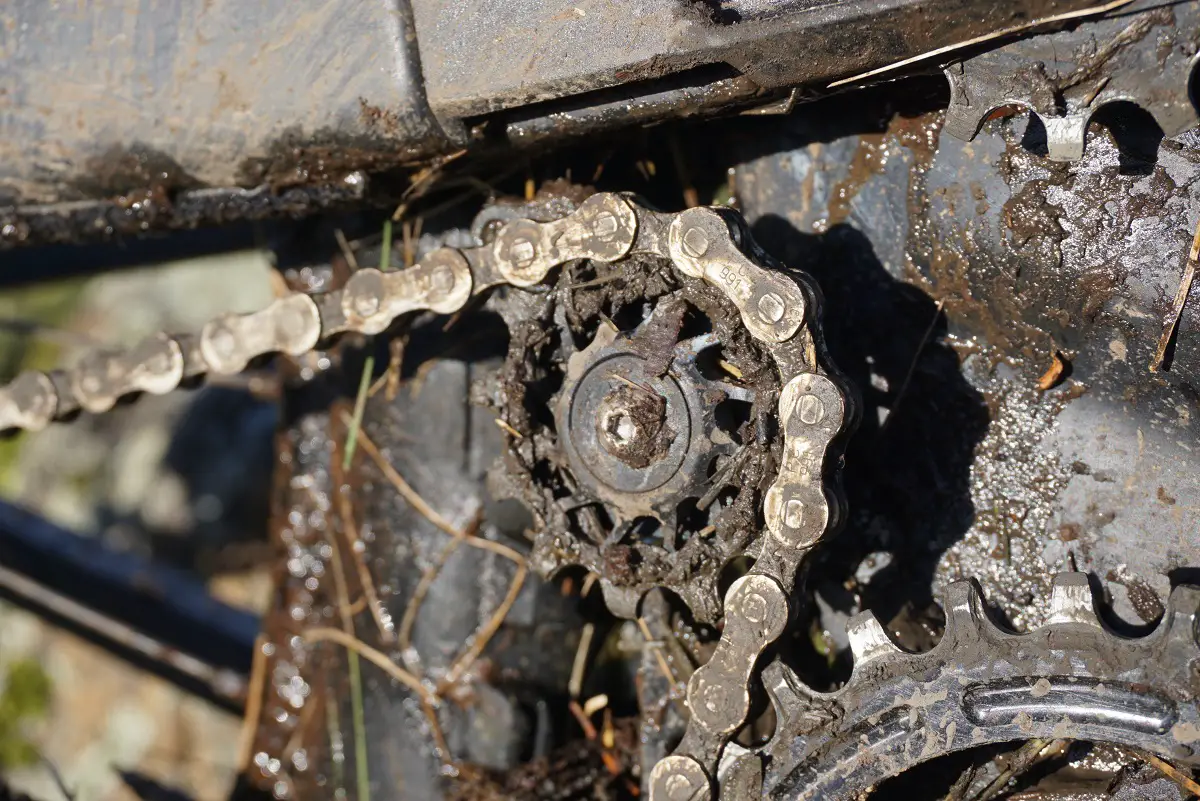
So what didn’t I like? Truth be told, not a whole hell of a lot. The suspension action is a significant step up from any other suspension bike I have ridden. I don’t say this lightly. The Guide simply works where others compromise. The weight could be reduced (lighter cranks please, Mr and Mrs Pinion!) but then there is always a trade-off between weight and strength. I would rather have the latter. For hike a bike, I found the bike easy to carry (the seat and top tube brace making for an unintentional carry handle). The drivetrain took a little getting used to but after years of riding derailleur gears, this shouldn’t be a surprise.
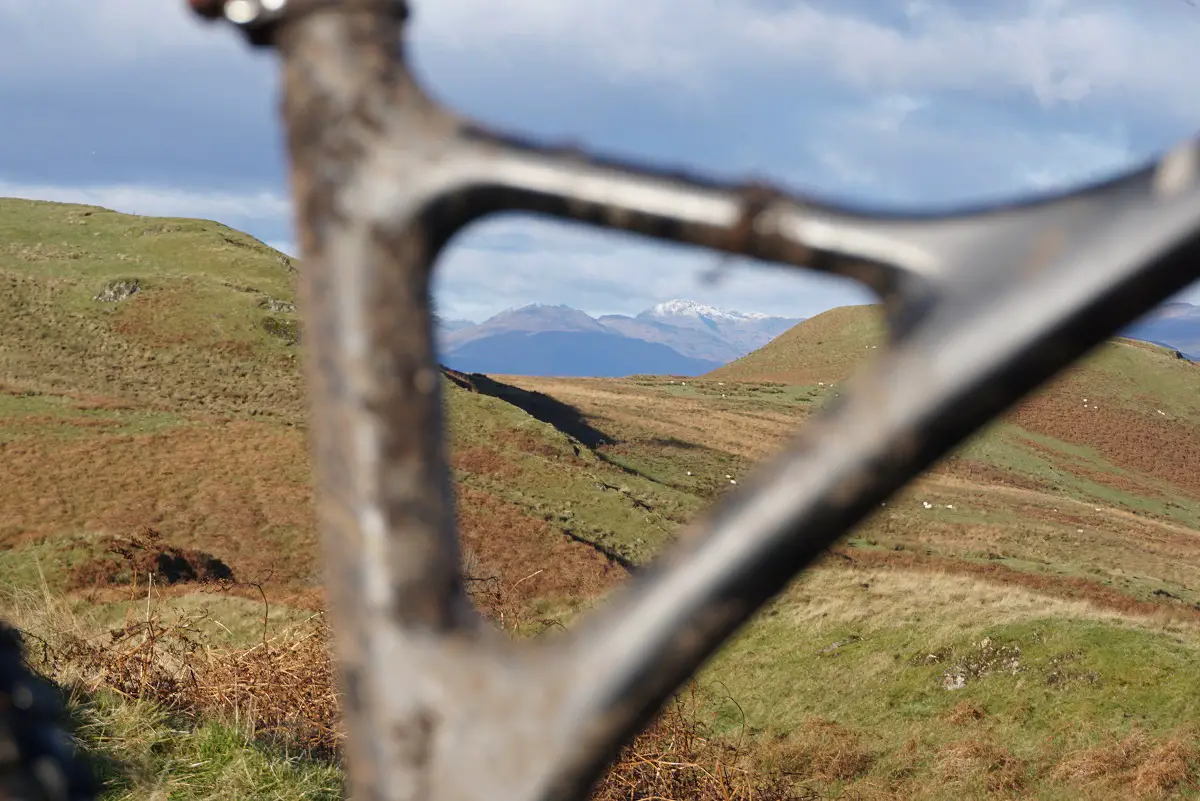
The weight concentrated in the middle makes for manuals being difficult to master while I had to relearn how to bunny hop. It’s funny how used to doing something you become but then find you have to change your technique for something as simple as shifting the balance point of your bike.
The test bike I had featured Velcro strips to deaden the sound of chain slap on rocky descents. It worked reasonably well but Deviate are spec’ing custom rubber channels on the production bike. There was a bit of noise from the idler but this was due to the chainring spacing on the original Pinion gearbox which was fitted for pre-production testing and the lighter C1.12 unit fitted for my test. Ben assures me that this has already been sorted for production.
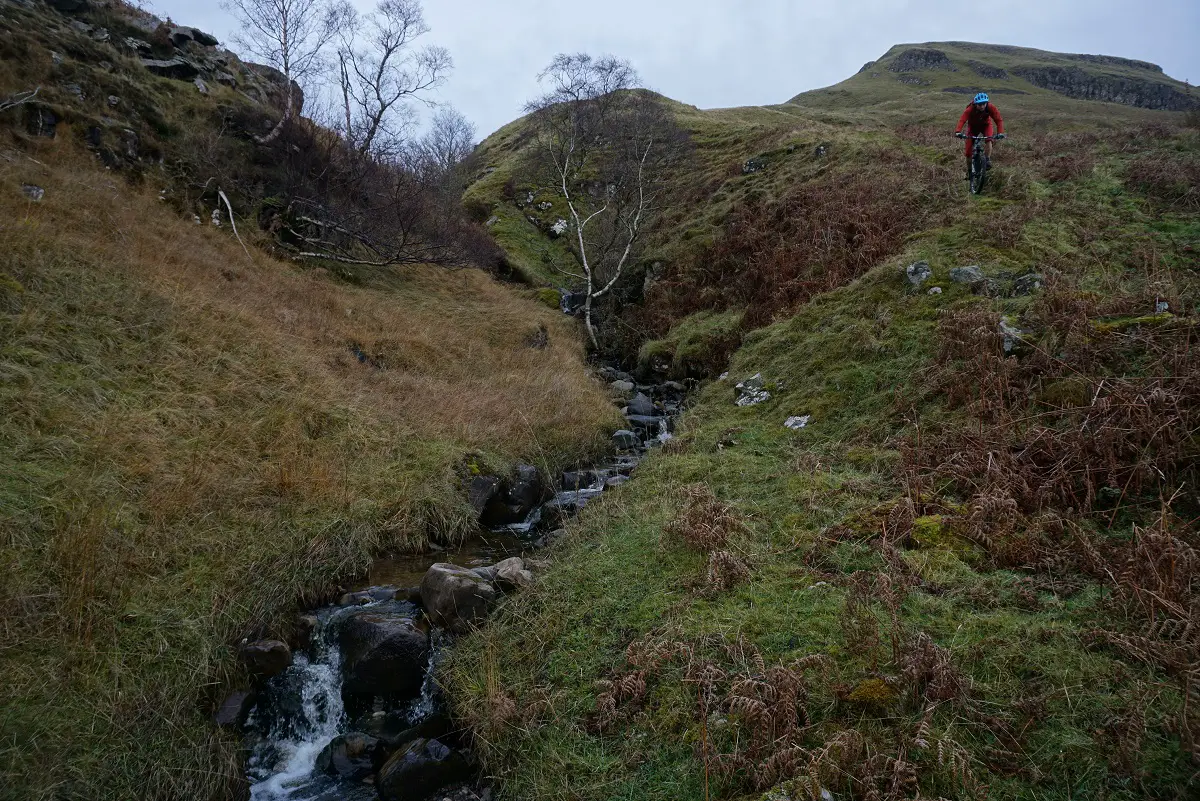
Most annoying in a true First World Problems sense is lubing a chain. With a freewheel built into the gearbox, back pedal and nothing happens. Argggggggggggggggggghhhhhhhhhh! I know it is but the most minor of minor inconveniences but it does mean you have to turn the bike upside down to lube the chain as you turn the cranks. Hardly a deal breaker though!
The last word.
So would I buy one? It would call for a long conversation with the long haired Finance Director but I could happily see me selling a couple of bikes to fund a purchase. It’s definitely not the kind of bike I would normally ride, but damn, it has really won me over. The suspension and drivetrain in combination have created a bit of a lightbulb moment for me. I reckon Deviate has created something pretty special. If this was from a big name manufacturer, riders would be falling over themselves to hand over their cash. £3,399 (or £5,699 for a complete UK build) is a lot of money in anyone’s book but if you consider that a competing carbon frame from another well-known brand costs £3k alone without figuring in the cost of a drivetrain, the Deviate Guide makes an awful lot of sense for the astonishing suspension performance it has to offer.
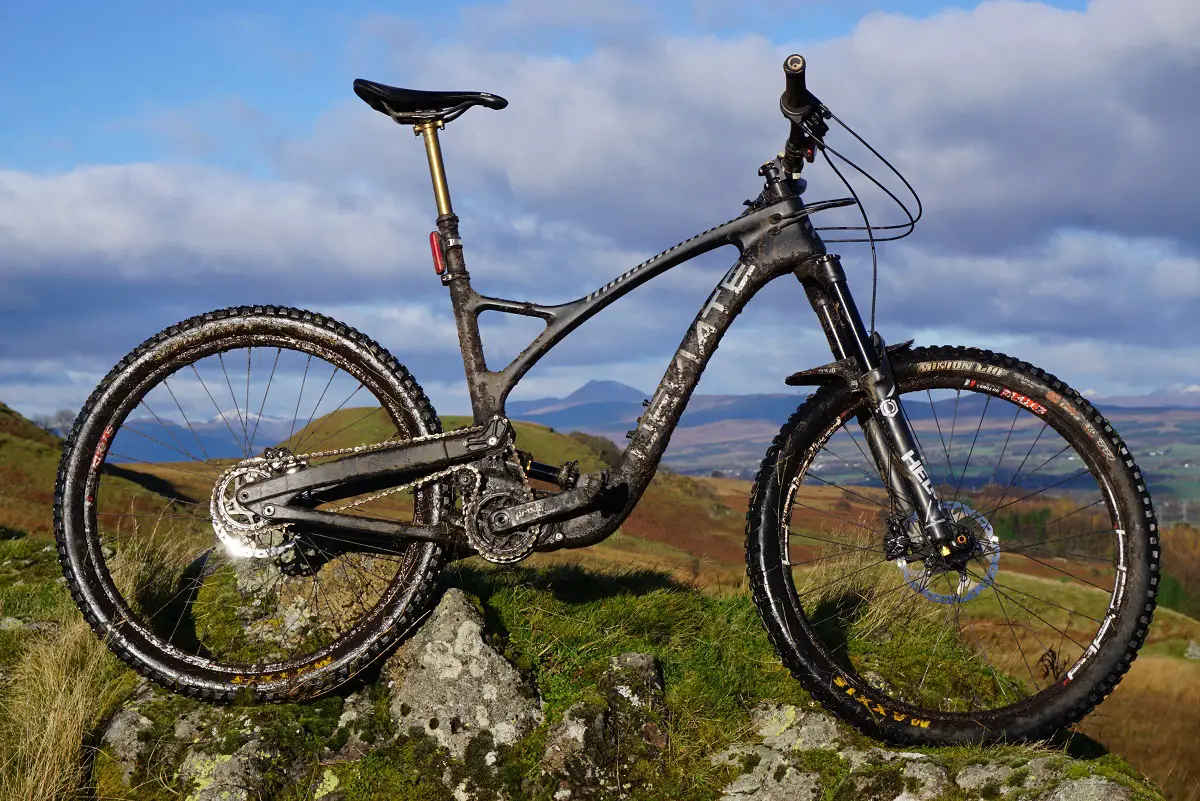
Price: £5,699 (£3,399 for frame, shock and gearbox drivetrain)
ST Recommended.
Comments (6)
Comments Closed

How come that Pinion hasn’t speced the gearbox with electrical servos? Seems like a logical thing to do.
@lagerblad – from what we’re aware, Pinion is working on it…
THAT, could be a major game changer in the bike market..
Good to see British engineering being used to produce an innovative design. Best of luck to the guys
I rode this bike on Tuesday night ride in utterly pitiful weather conditions and you.can.just.tell that it was designed by someone who knows what it’s like to ride in mud and the wet!! It has a lovely burst of acceleration in low gears; not sure why! I put it down to the gears and the low centre of gravity.
I rode this bike on Saturday with Ben. Wow. No marketing bs and they don’t try to hide anything.
It is a bit heavier than my Bronson cc, the gearbox takes a little getting used to but the bike is fantastic. I rode at dunkeld and rode a mix of dh and single-track, bearing in mind it’s not a dh bike it rode fantastically. Even small bumps on the climb were non existent. I rode up the lower section of the dh track for a bit as it’s easy to see no one is coming down, it went over roots and rocks on really steep bits and wouldn’t slip, only losing my line causing the front wheel to stop made me stop the bike.
I am now committed to owning one, just a question of how. I only bought the Bronson this year and the guide has shown me what a near uncompromised suspension set up can be. It was not great getting back on the SC and riding the same trails!